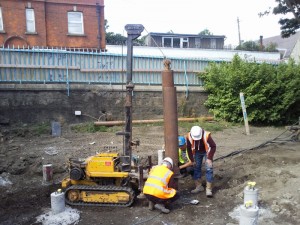Pile Testing
Pile testing is used to determine conditions of a pile after installation, such as; load carrying capacity, pile bearing capacity, resistance distribution and shape and integrity evaluation of the foundation element. Depending on the engineer’s design specifications, up to three methods can be employed for pile testing. These are Pile Integrity Tests, Dynamic Load Tests and Static Load Tests.

-
Pile Integrity Test (PIT)
This particular test is based on wave propagation theory. It is a low strain method that uses a hammer to provide a small impact to the pile. This impact produces a compressive wave that traverses down the pile at constant speed. Only when there are irregularities in the pile, such as concrete voids, diameter reductions, intrusion of foreign matter etc., do the results show a wave reflection. It is typically a very cost-effective method for pile testing and also not comparatively (to other methods) time-consuming
-
Dynamic Load Test (DLT)
Dynamic testing is a high strain method used to determine a pile’s bearing capacity. The method involves impacting the head of the pile with a dynamic load (such as a hammer or drop weight) and measuring the resultant strains and accelerations. This data sample can then be used to quantify the pile and soil behaviour in response to the dynamic force. The method can be performed on all piles regardless of how they were installed. It is also a relatively quick and economical method for pile testing.
-
Static Load Test (SLT)
A Static load test is the most fundamental form of pile testing. It involves directly measuring the displacement of the pile head in response to a physically applied test load. The physical load can be applied via a jack acting against a reaction beam which in turn is being restrained by some sort of anchorage system (such as adjacent tension piles). Another similar method would be to use a jack and Kentledge system which utilises a dead weight as the reactive force. The nominated test load is applied in increments and sustained for specific time periods as typically determined by the design engineer. Pile head displacement is monitored and recorded throughout.
